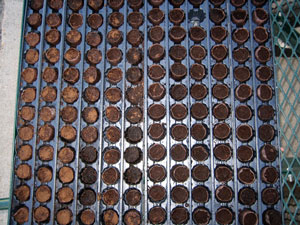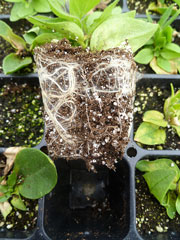1/25/2012
Irrigation in Propagation
Jason Fatten

In previous articles, I explained applying mist to the topside of cuttings in propagation. This time around, we’ll look at the bottom side of water management. Managing soil moisture is critical to successful uniform root formation and development. Maintaining saturated media is the most common cause of non-uniform rooting of cuttings. Let’s look at the stages of rooting and the appropriate moisture levels.
This checkerboard pattern formed with saturation of only the cells on the right.
How wet to start?
The first stage in propagation is media preparation. Cuttings should be stuck in wet media. But how wet? Wet! This is the one and only opportunity to ensure uniform moisture from cell to cell. The easiest method is to ensure complete saturation or a moisture level 5. In many instances, the “checkerboard pattern” of uneven cell drying that appears later in propagation actually begins early on. Uneven media moisture at the Point of Commitment (when cutting meets soil) develops into uneven rooting later. Saturate media completely within 24 hours of sticking.
Remember peat moss is hydrophobic. Some stabilized media containing peat moss are more difficult to saturate. Applications of hot water or wetting agents help to hydrate these types of media. Media should be dark brown to black and shiny.
I like to water cuttings once stuck and placed on the bench in the greenhouse to saturate the media from the top all the way to the bottom. This irrigation settles the media, contacting more surface area of the cutting stem. Free-water in the media can help rehydrate cuttings. Some cuttings act like cut flowers and pull water up their stems to rehydrate, relying less on extra moisture applied by mist.
Cuttings need free-water to produce callus. This period lasts for two to seven or more days. It’s important to know the length of time specific to each crop. Crops that callus quickly and maintain a saturated level for longer than appropriate will have delayed root development. Likewise, root development likely will not occur in slow-rooting crops that dry before callus formation has time to occur. During the callus-formation stage, maintaining moisture at a level 5 is difficult for long periods and often leads to increased disease pressure—especially in slow-callusing crops.
Maintaining a level 4 allows enough free-water to continue the callusing process without oversaturation. Gravity keeps more water in the bottom of the cell, where the base of the cutting is located, than the top.
How and when to dry
Begin drying media when callus has formed. Reduce mist and irrigation three to six days after sticking cuttings. Media dries faster in warm temperatures with low relative humidity. This environment places extra water stress on cuttings, but cuttings tolerate some slight wilt during this stage. Moisture level 3 has just enough free water for the soil to encourage emerging roots. Media should be light brown in color.
 Roots don’t grow in water, fish do!
Roots don’t grow in water, fish do!
Roots need air to grow. When roots appear at the sides of the cell, dry media to a level 2 before irrigating to build the best roots. A dry media with just enough free water to sustain the plant will cause roots to branch and produce fibrous hair roots. Thick, pencil-like roots are a sign the media is too wet. In dry conditions, plants need hair roots to search for and find what water is still available in the media. Growing hair roots grows healthier plants. More root tips and surface area absorbs more water and nutrients.
Fibrous roots growing only on the top layer.
Remember media is a three-dimensional space. Uniform moisture from top to bottom allows roots to grow in the entire cell space. A wet bottom grows roots only on the top layer, and a wet top grows roots only on the bottom. Roots will not grow into saturated media when they are happily thriving in dry levels.
Proper media moisture is important at each stage during propagation. Lack of uniformity of moisture or placing water in the wrong place in the cell affects quality more than any other cause. Water is a key ingredient to building roots, but when properly managed creates the best quality plant.
GT
Jason Fatten is technical manager for Ball Innovations in West Chicago, Illinois.